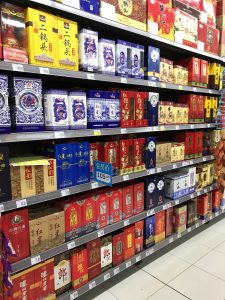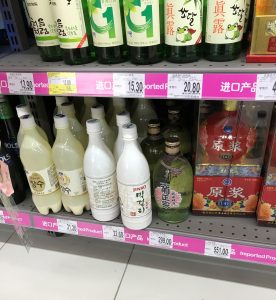This is the third and final story of the heated battle in the supermarkets of Beijing. This time, I will discuss the alcohol floor.
It is said that the first alcohol in China was brewed more than 5,000 to 6,000 years ago. The supermarket certainly had a variety of good alcohol and I wondered how to choose the best one for me. The floor had a lot of drinks in order to appeal to the 20 million citizens living in Beijing, which has a long history of alcohol. It covered everything such as Chinese liquor, high-end whiskey, Brandy and so on. It was comparable to a duty free shop at an airport.
Among them, Baijiu is one of the most famous Chinese liquors. There were so many kinds that I couldn’t pick up every bottle to take a look at all of them to choose the best one for me. Eventually, I found myself looking at the appealing packaging.
A lot of money is spent for the package to have a high-class appearance: gold foil and silver foil stamping, embossing, glossy print, matte finish, etc. (See the upper image) I realized again that the package raises the product value and determines the motivation to purchase when there are many choices of a similar product.
The next moment I noticed a few brown bottles shoved in the back of the bottom shelf (See the lower image) As I looked carefully, one of the 1.8 liter bottles had some dust on it. Oh no, I thought, it was a well-known brand of Japanese sake! They had been produced in 2012, but none of them were sold and remained in the showcase.
In Japan there are not so many bottles of sake packaged in gift boxes. Unfortunately because of the lack of packaging, it seemed that the unsold bottles of Sake were not regarded as valuable compared with other packaged liquors. Outer cartons for products are mandatory in order to attract customers not only in China but all over the world.
I strongly hope that companies of corrugated and paper folding cartons will help sake to be valued as a packaged product in global market.

Packages of Chinese liquors appearing high-class






